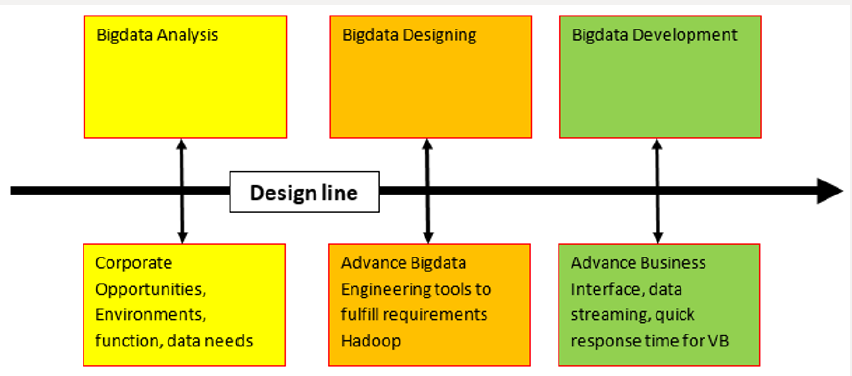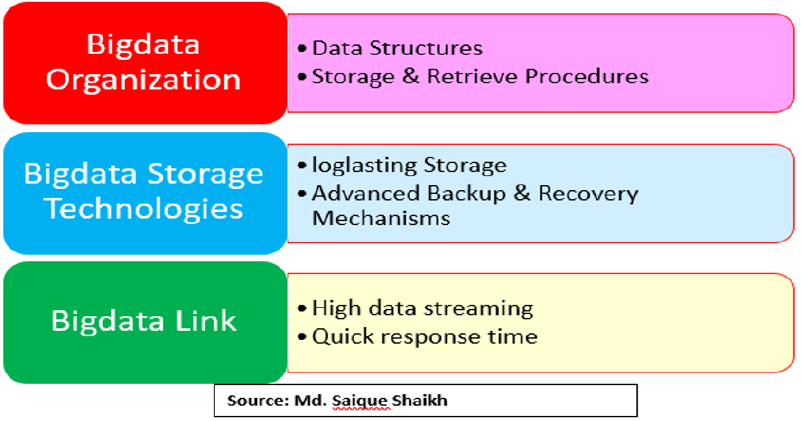
Lupine Publishers Group
Lupine Publishers
Menu
ISSN: 2643-6736
Short Communication(ISSN: 2643-6736) 
Insight Bigdata Management Modeling for Business Virtualization Volume 1 - Issue 3
Sadique Shaikh* and Tanvir Begum
- Department of Management & Science (IMS), MS, India
Received: October 18, 2018; Published: October 25, 2018
*Corresponding author: Md Sadique Shaikh, KYDSC Trust’s Institute of Management & science, Sakegaon-Bhusawal, MS, India
DOI: 10.32474/ARME.2018.01.000115
Abstract
Bigdata design, development and implementation are emerging need of today’s Business Virtualization and future world strongly depend on this emerging and needful technology of Bigdata and Bigdata management to generate BIS dash-boards front of business decision makers using business analytics as we discussed with the help of two models in this paper [1-6].
Keywords: Bigdata; Bigdata management; Hadoop; Business virtualization
Modeling
Bigdata Design Line Model
This is our first developed model related to Bigdata and Business virtualization. This model has expansion through design line from Bigdata Analysis to Bigdata Designing and Bigdata Designing to Bigdata Development with their respective designing essentials and functions. At stage one Bigdata analysis fundamental considerations are Corporate Opportunities, Environments, function, data needs. At stage two Bigdata designing is Advance Bigdata Engineering tools to fulfill requirements using Hadoop or other one and at the stage three Bigdata development we need to Advance Business Interface, data streaming, quick response time for Business Virtualization (VB). These are the few which I covered likewise several facts and figures need to gather and revised timely to keep update in Bigdata technologies and Business virtualization, but most common for all covered on model (Figure 1).
3B Models of Bigdata Engineering
This is second important model which purely discussed to Bigdata engineering requirements considering three most important factors which are Bigdata Organization, Bigdata Storage Technologies and Bigdata Link. The first one important factor Bigdata Organization concern to innovative data structures, storage technologies-media and procedures to retrieve engineering whereas Second parameter Bigdata Storage Technologies engage to design long-lasting Storage, Advanced Backup & Recovery Mechanisms. The third important criterion is Bigdata Link where engineering must need to carry on High data streaming and Quick response time (Figure 2).
Conclusion
We had developed two models for better understanding with Bigdata and Business Virtualization labeled as Bigdata Design Line Model and 3B Model of Bigdata Engineering. Through these models we focused on engineering aspects of Bigdata as well as discuss essential of its like to compete in this environment, broadband operators are trying to implement Big Data projects that give them new insights into their network and subscribers. Operators have many disparate systems that send bits of information into the Telco’s data mart, but the data is fragmented and not very granular.
Operators often have probes deployed in their networks, but most focus on signaling information and they lack KPIs on the actual broadband experience delivered to the subscriber - resulting in customer complaints of a slow network and the operator responding that their network is up, so it can’t be their problem. These systems are not integrated into the OSS/BSS and do not perform subscriber correlation in real-time, losing opportunities to proactively deliver targeted offers and rectify problems before a subscriber realizes that there is an issue on the network. Operators are also looking to monetize their subscriber usage data externally, but they often lack the granularity and correlation of that data to maximize the value to external audiences like enterprises, retail, or advertising companies.
Acknowledgement
I would like to credit this work to my loving wife Safeena Khan, my angels Md Nameer Shaikh, Md Shadaan Shaikh and my close friend Tanveer Sayyed.
References
- h t t p : / / w w w. c i s c o . c o m / c / e n / u s / p ro d u c t s / c l o u d ‐ sys te m s ‐ management/data‐analytics/index.
- http://www.techtarget.com/contributor/Rick‐Van‐Der‐Lans.
- http://www.b‐eye‐network.com/channels/5087/articles/
- http://www.b‐eye‐network.com/channels/5087/view/12495
- RF Van Der Lans (2007) Introduction to SQL; Mastering the Relational Database Language, 4th edn); Addison‐Wesley.
- RF Van Der Lans (2012) Data Virtualization for Business Intelligence Systems. Morgan Kaufmann Publishers.

Top Editors
-

Mark E Smith
Bio chemistry
University of Texas Medical Branch, USA -

Lawrence A Presley
Department of Criminal Justice
Liberty University, USA -

Thomas W Miller
Department of Psychiatry
University of Kentucky, USA -

Gjumrakch Aliev
Department of Medicine
Gally International Biomedical Research & Consulting LLC, USA -

Christopher Bryant
Department of Urbanisation and Agricultural
Montreal university, USA -

Robert William Frare
Oral & Maxillofacial Pathology
New York University, USA -

Rudolph Modesto Navari
Gastroenterology and Hepatology
University of Alabama, UK -

Andrew Hague
Department of Medicine
Universities of Bradford, UK -

George Gregory Buttigieg
Maltese College of Obstetrics and Gynaecology, Europe -

Chen-Hsiung Yeh
Oncology
Circulogene Theranostics, England -
.png)
Emilio Bucio-Carrillo
Radiation Chemistry
National University of Mexico, USA -
.jpg)
Casey J Grenier
Analytical Chemistry
Wentworth Institute of Technology, USA -
Hany Atalah
Minimally Invasive Surgery
Mercer University school of Medicine, USA -

Abu-Hussein Muhamad
Pediatric Dentistry
University of Athens , Greece

The annual scholar awards from Lupine Publishers honor a selected number Read More...















